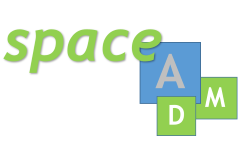 spaceADM is a real time algorithm to evaluate satellite attitude based on Kalman Filter theory. It is able to integrate data from different devices (Star Trackers, Gyros, Sun Sensors, etc.) in order to provide highly precision estimates to satellite attitude.
spaceADM is a real time algorithm to evaluate satellite attitude based on Kalman Filter theory. It is able to integrate data from different devices (Star Trackers, Gyros, Sun Sensors, etc.) in order to provide highly precision estimates to satellite attitude.
On-board measurements need a refinement step to provide valuable data to the attitude control system. Sensor fusion through Kalman filtering significantly improves the on-line estimation reducing the effect of sensor noise and bias. While current approach adopts a standard Extended Kalman Filter (EKF) processing, spaceADM overcomes the limited performances provided by EKF through the exploitation, at its most, of the characteristics of an Unscented Kalman Filter (UKF).
 To make it feasible spaceADM applies several mathematical and engineering innovative approaches to decrease computational cost while increasing precision.
To make it feasible spaceADM applies several mathematical and engineering innovative approaches to decrease computational cost while increasing precision.
spaceADM ensures high precision even in the case of highly-non linear functions, that’s to say, when the satellite follows “non stable orbits” with very rapid variations in time.
Even in absence of gyro’s measurements, the algorithm implemented in spaceADM is able to achieve high precision estimates combining kinematics and dynamics models.
spaceADM is able to provide high precision estimates for different kind of satellites: from pico to nano platforms. Furthermore it is particularly suitable for CubeSats, which are particularly prone to noisy measurements.
 When using Star Tracker data, an attitude error estimate lower than 30arcsec per axis (Roll, Pitch and Yaw) is achieved.
When using Star Tracker data, an attitude error estimate lower than 30arcsec per axis (Roll, Pitch and Yaw) is achieved.
Different devices can be used for attitude determination:
- Star Tracker
- Gyro
- Accelerometer
- Magnetometer
- Sun senor
 spaceADM can be used both on board and on ground. On board, it is able to provide attitude measurements in real-time. On ground it can be used to improve the attitude and the orbit estimation.
spaceADM can be used both on board and on ground. On board, it is able to provide attitude measurements in real-time. On ground it can be used to improve the attitude and the orbit estimation.
Attitude is orientation of a defined spacecraft body coordinate system with respect to a defined external frame. Attitude determination refers to the process of measuring and determining spacecraft orientation. Controlling vehicle attitude requires sensors to measure vehicle orientation, actuators to apply the torques needed to re-orient the vehicle to a desired attitude and algorithms to command the actuators based on sensor measurements of the current attitude and specification of a desired attitude.
MAIN FUNCTIONALITIES:
- Attitude estimation using new approaches;
- Able to use different devices;
- Can be used on all kinds of satellite;
- High-accurate estimation;
- Accurate even with high nonlinearity.
Download here the spaceADM Brochure (PDF)

